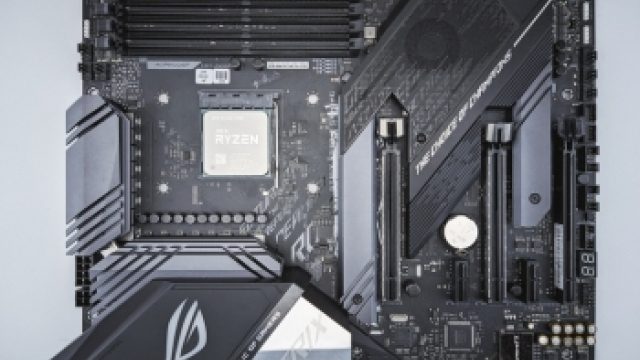In the world of PC building, choosing the right components can be an exciting yet perplexing endeavor. One critical question that often arises is, “Will an ATX motherboard fit in an EATX case?”
Let’s dive into the nitty-gritty of this compatibility conundrum and explore how you can navigate the intricacies of case and motherboard sizing.
Understanding ATX and EATX Motherboards
To begin our journey, we must first grasp the essence of ATX and EATX motherboards.
The ATX (Advanced Technology eXtended) standard is the most prevalent motherboard form factor, known for its versatile design and widespread adoption.
EATX (Extended ATX), on the other hand, is a larger variant of ATX, providing additional space and ports for enhanced functionality and performance.
EATX Case Dimensions and Features
EATX cases, owing to their larger size, offer a plethora of advantages. They can accommodate multiple graphics cards, increased storage options, and robust cooling systems.
However, due to their dimensions, not all EATX cases can house ATX motherboards without a hitch.
ATX Motherboard Dimensions and Specifications
ATX motherboards usually measure 12 x 9.6 inches (30.5 x 24.4 cm). Their standardized dimensions allow for widespread compatibility with various cases and components.
However, the pivotal question remains: will these ATX boards fit seamlessly into EATX cases?
Compatibility Factors Between ATX Motherboards and EATX Cases
When considering compatibility, size is not the only aspect to ponder. Some EATX cases may lack certain standoff holes or features required for securing an ATX motherboard effectively. This can lead to alignment issues, potentially resulting in damage to sensitive components.
Overcoming Size Limitations: Using ATX Motherboards in EATX Cases
Fear not, for where there’s a will, there’s a way! Overcoming the size mismatch involves strategic planning and sometimes, a touch of creativity.
Utilizing standoffs and spacers can help stabilize an ATX motherboard in an EATX case, minimizing the risk of misalignment.
Related Article: Micro ATX vs Mid Tower: Choosing the Perfect PC Case
Case and Cooling Considerations
While the ATX motherboard may find its place within the EATX case, another crucial factor comes into play – cooling.
Larger cases offer more room for airflow, but it’s essential to ensure that your cooling solutions adequately cover your components’ needs, especially if you engage in resource-intensive tasks like gaming or video editing.
Real-World Examples: Case and Motherboard Compatibility
Let’s delve into real-life scenarios to grasp the intricacies of case and motherboard compatibility. Take, for instance, the “Gaming Rig Supreme” build.
A passionate gamer wanted to house their beloved ATX motherboard in a spacious EATX case, but compatibility issues arose. With some ingenious modifications and the use of custom brackets, the gaming rig achieved a harmonious union, leaving room for future upgrades.
Upgrading from ATX to EATX: What to Expect
If you’re contemplating an upgrade from ATX to EATX, there are a few essential points to consider.
Besides ensuring the compatibility of your new components, you may also need to reevaluate your power supply and cooling options. The upgrade can yield significant benefits, but a well-informed decision is key to a successful transition.
Manufacturer Guidelines and Recommendations
Manufacturers often provide specific guidelines and recommendations regarding case and motherboard compatibility.
It’s vital to heed these instructions, as they are based on thorough testing and analysis to ensure optimal performance and stability.
Related Article: What is ATX motherboard: Understanding its Features
Community Insights and Expert Opinions
The PC-building community is a wealth of knowledge when it comes to practical insights and expert opinions.
Engaging with forums and seeking advice from experienced enthusiasts can offer valuable information and tips to make your ATX-to-EATX journey smoother.
Choosing the Right Case for Your ATX Motherboard
To avoid compatibility issues altogether, it’s essential to choose the right case for your ATX motherboard.
Before making a purchase, thoroughly research the case’s specifications and dimensions, ensuring that it explicitly supports ATX motherboards without any compromises.
DIY Modifications: Should You Attempt It?
While DIY modifications can be enticing, it’s crucial to tread carefully. Unless you possess the necessary technical expertise, attempting major modifications to fit an ATX motherboard into an EATX case might do more harm than good. Consulting a professional or opting for a more compatible case might be a safer choice.
FAQs About Will an ATX Motherboard Fit in an Eatx Case
What is the difference between EATX and ATX case?
EATX (Extended ATX) cases are larger than standard ATX cases, providing more space for components and additional expansion slots.
This allows for larger motherboards and improved airflow for high-performance systems.
Will any ATX motherboard fit in any ATX case?
Yes, ATX motherboards are designed to fit into ATX cases.
The standardized form factor ensures compatibility between ATX motherboards and ATX cases, making them widely interchangeable.
Is EATX better than ATX for gaming?
Whether EATX is better than ATX for gaming depends on individual preferences and the specific requirements of the gaming setup.
EATX offers more expansion options, ideal for multi-GPU setups, while ATX can suffice for most gaming configurations.
Will an ATX motherboard fit in a microATX case?
No, an ATX motherboard will not fit in a microATX case. MicroATX cases are designed to accommodate smaller motherboards, such as microATX and mini-ITX, offering a more compact and space-saving solution.
Which type of motherboard is compatible with ATX cases?
ATX cases are designed to be compatible with ATX motherboards, as well as microATX and mini-ITX motherboards, making them versatile and widely used in various system builds.
Is ATX obsolete?
No, ATX is not obsolete. It remains a prevalent form factor for motherboards and cases due to its flexibility and compatibility. Many modern systems still use ATX components.
How do I know if my motherboard will fit in my case?
To ensure compatibility, check the form factor of both the motherboard and the case.
If they have the same form factor (e.g., ATX, microATX), they should be compatible. Also, verify the dimensions and specifications in the product manuals.
Can you put an ATX motherboard in a server case?
Yes, it is possible to install an ATX motherboard in a server case, provided that the server case supports the ATX form factor.
Some server cases are designed to accommodate multiple form factors, including ATX.
Will all motherboards fit in all cases?
No, not all motherboards will fit in all cases. Motherboard form factors vary, such as ATX, microATX, mini-ITX, and EATX, and they require specific cases designed to accommodate their respective sizes.
How many RAM slots does EATX have?
The number of RAM slots on an EATX motherboard can vary, but typically they offer more RAM slots compared to standard ATX motherboards.
EATX motherboards often come with 8 RAM slots or more, allowing for greater memory capacity.
What is the biggest motherboard size?
The biggest motherboard size is EATX (Extended ATX). EATX motherboards are larger than standard ATX motherboards and are designed to provide extra expansion options, making them ideal for high-performance systems and enthusiasts seeking additional capabilities.
Final Thoughts About Will an ATX Motherboard Fit in an Eatx Case
In conclusion, an ATX motherboard will fit in an EATX case with ease. EATX cases are specifically designed to accommodate larger motherboards like ATX and offer extra expansion possibilities.
The compatibility ensures that users have the flexibility to utilize ATX motherboards in EATX cases without any issues.
This allows for more significant system configurations, additional graphics cards, and increased cooling capabilities. Whether you opt for an ATX or EATX case, it’s essential to consider your specific requirements and future upgrade potential. Overall, the seamless integration of ATX motherboards in EATX cases provides a versatile solution for building high-performance systems with ample room for customization.


